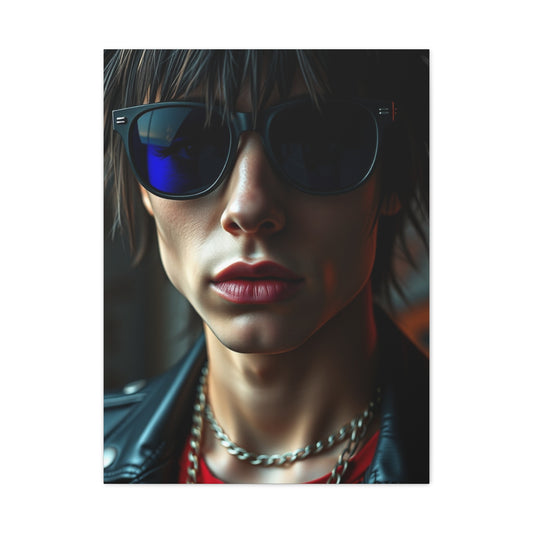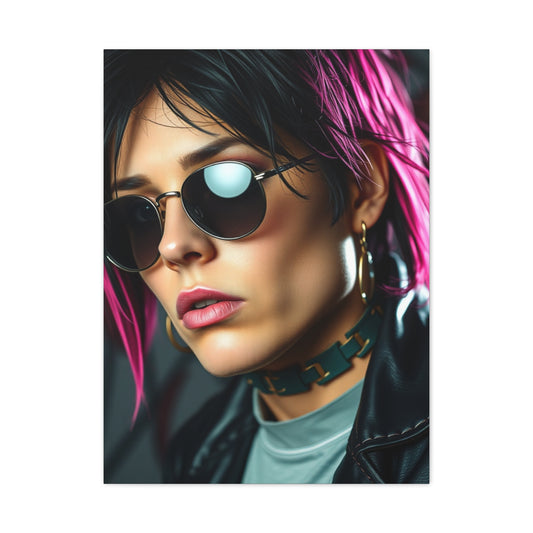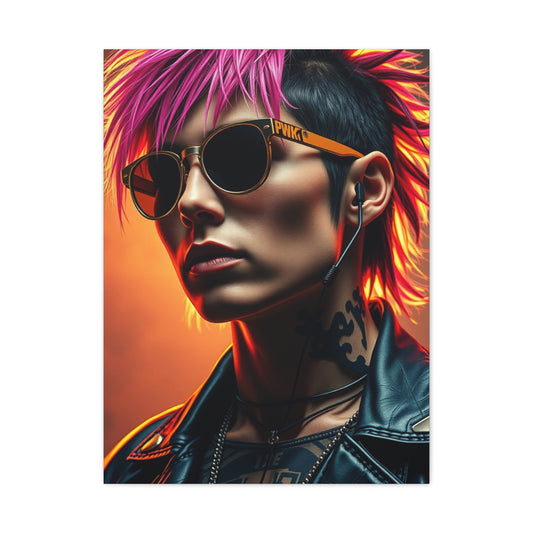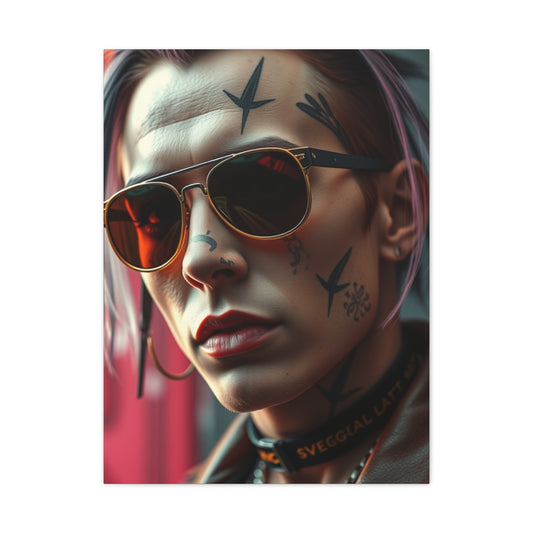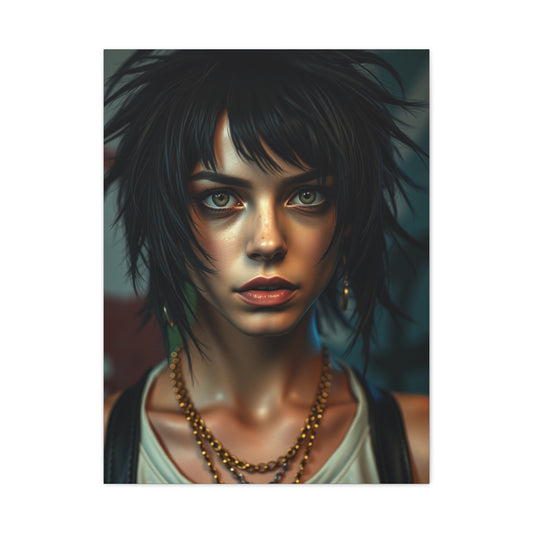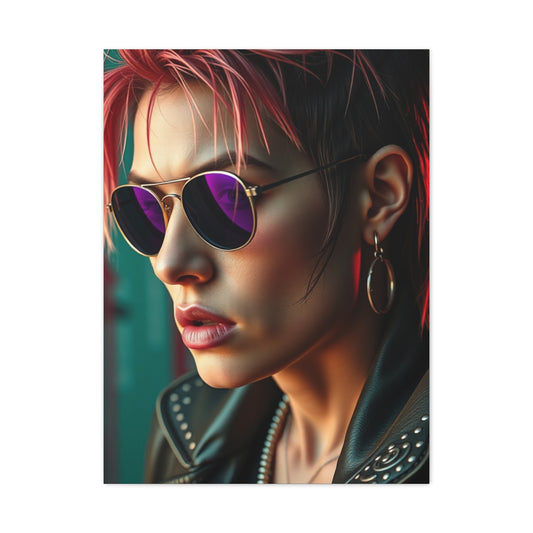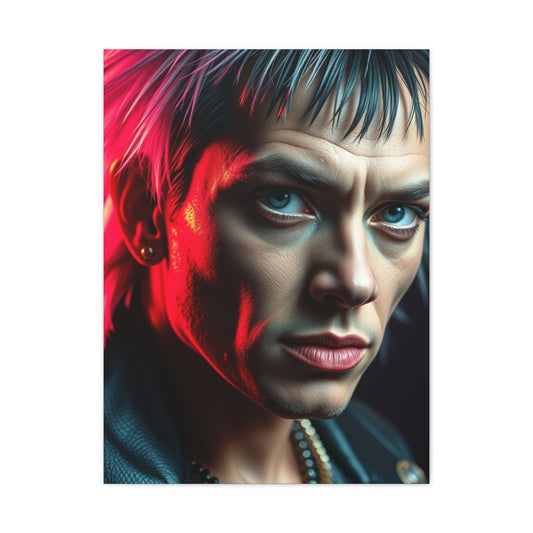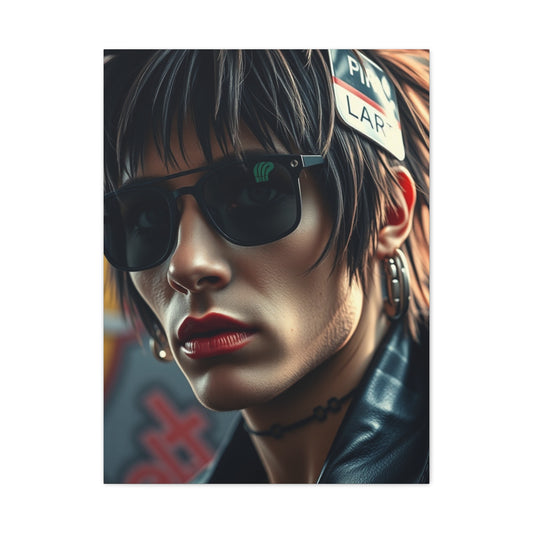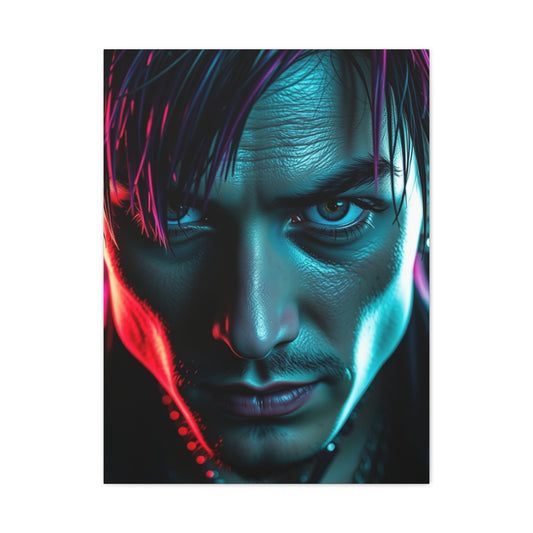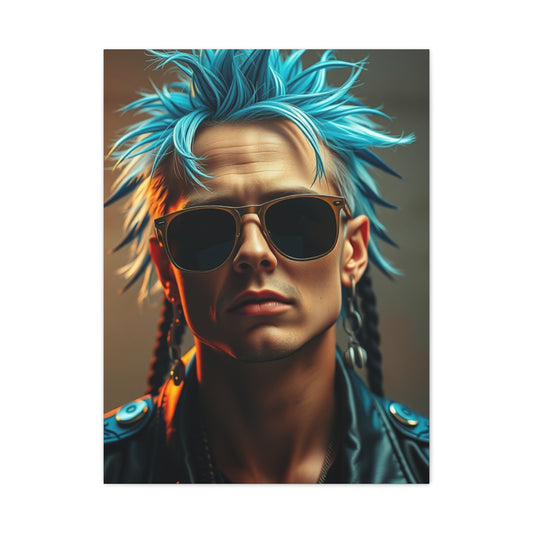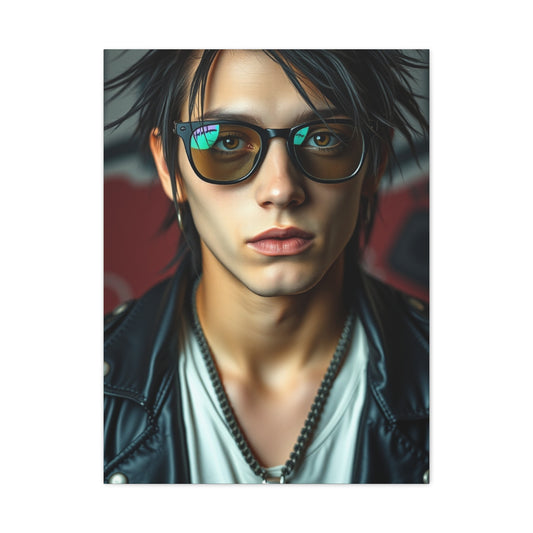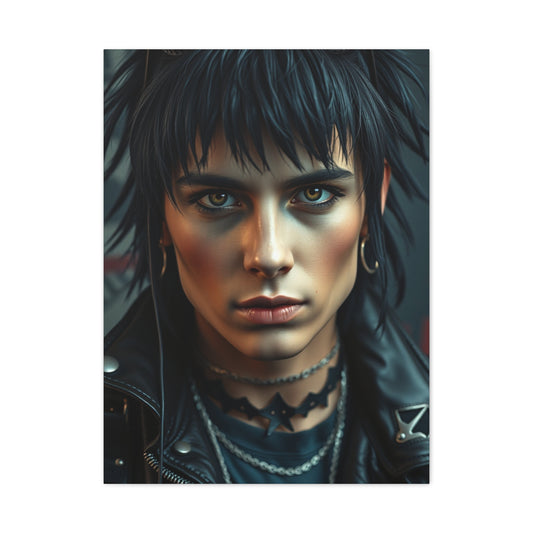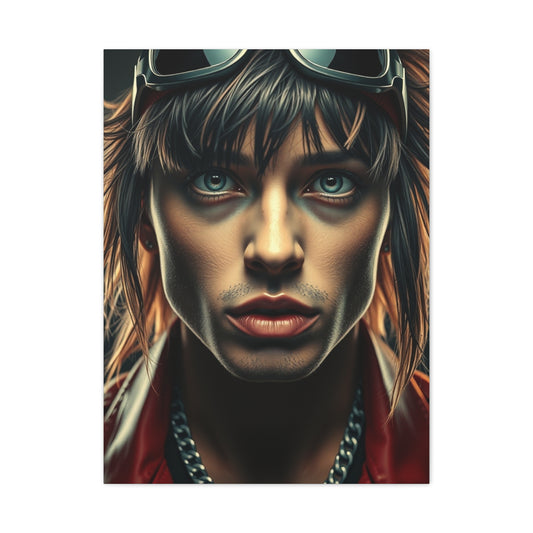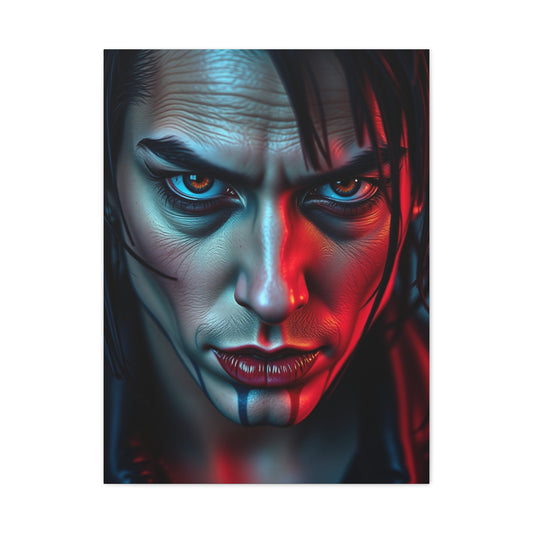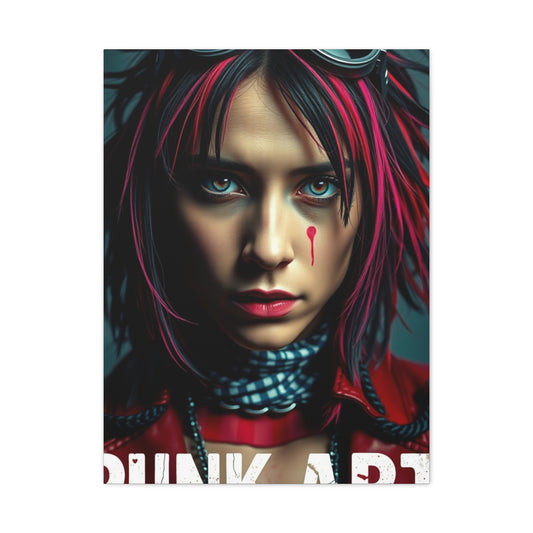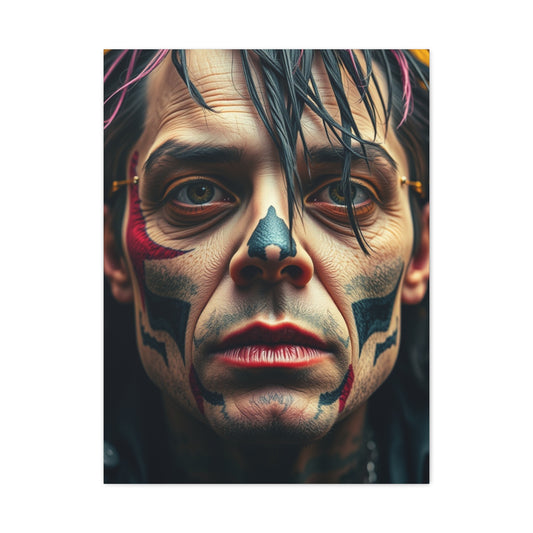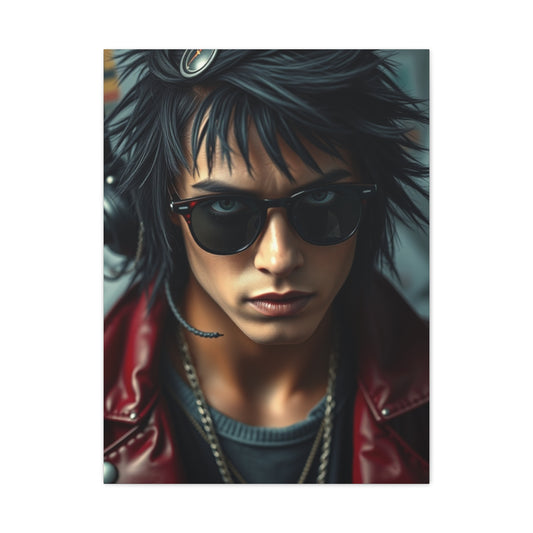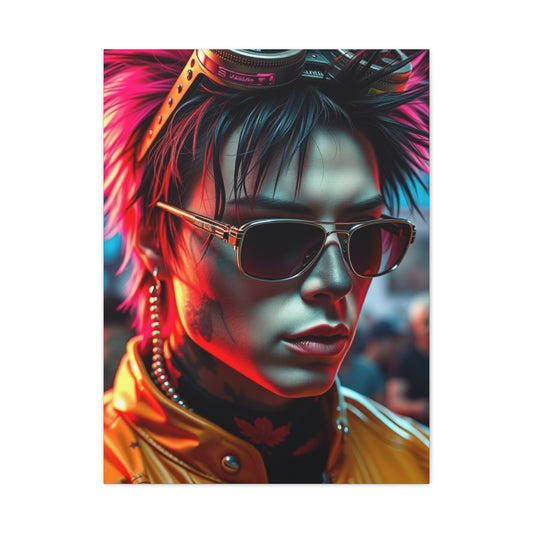Punk and Post-Punk Wall Art Inspirations
Punk and post-punk art represent one of the most striking ruptures in modern cultural history. They were not merely offshoots of music or temporary fashion experiments but rather comprehensive cultural shifts that redefined the way creativity could exist in society. Emerging during the bleak socio-economic climate of the late 1970s, punk challenged the inertia of mainstream culture by tearing down the barriers of convention. It encouraged people who had previously been excluded from elite creative spaces to produce their own music, visual works, writing, and film using whatever means were available. This was not simply about sound or clothing; it was a declaration of autonomy, a visceral announcement that imagination belonged to everyone, not just those sanctioned by institutions.
When punk’s first wave reached its limits, a subsequent generation evolved from its groundwork, moving toward post-punk. While punk often emphasized urgency, ferocity, and simplicity, post-punk embraced experimentation, intellectualism, and cross-genre innovation. Where punk was demolition, post-punk was reconstruction. This shift mirrored broader social transitions, including the rise of new political regimes and the disillusionment of youth under systems of neoliberal conservatism. The art born out of this transformation remains influential today, shaping graphic design, performance, fashion, and the philosophy of cultural production.
Historical Background
The roots of punk can be traced to a moment of stagnation in Western culture during the mid-1970s. Popular music had become dominated by highly polished rock acts, stadium spectacles, and elaborate productions that felt inaccessible to ordinary people. In Britain, economic crises, unemployment, and a growing generational divide left youth alienated and disillusioned. In the United States, similar sentiments were felt in cities like New York, where deindustrialization created urban decay. Against this backdrop, punk emerged as a visceral response.
Bands such as the Ramones in New York and the Sex Pistols in London embodied this discontent, channeling raw aggression and stripped-down energy into music and performances that broke radically from the status quo. Their aesthetics were confrontational, their lyrics unapologetically bleak or satirical, and their imagery often derived from bricolage—appropriating fragments from mass culture, newspapers, or discarded materials. This reflected the fractured social environment that surrounded them.
From 1976 to 1979, the first wave of punk established its ethos: speed, minimalism, directness, and a do-it-yourself spirit. But by the turn of the 1980s, the cultural climate was shifting. Punk’s raw simplicity was both liberating and limiting. Many of its practitioners began searching for new expressive vocabularies that could sustain artistic innovation while retaining the confrontational energy of the movement. This gave rise to post-punk, a category less defined by strict style and more by its openness to fusion.
The election of Margaret Thatcher in Britain and Ronald Reagan in the United States reshaped the political atmosphere, fueling a climate of conservative dominance, consumer capitalism, and widening inequality. Artists and musicians responded by deepening their experimentation, channeling punk’s anti-establishment ethos into new, hybrid cultural forms. Post-punk thus became a bridge between rebellion and artistry, a realm where underground creativity flourished in the face of social retrenchment.
Core Concepts and Foundations
The essence of punk art lay in its demolition of hierarchies. It dismantled the idea that only trained experts could create cultural value. It emphasized accessibility, often using crude materials, handmade graphics, and fragmented styles that rejected traditional polish. Its spirit was deeply performative, turning even small-scale concerts or makeshift exhibitions into collective experiences of defiance.
Central to punk was the principle of DIY. This meant not waiting for permission from established cultural institutions but instead producing records, designing posters, making zines, or staging performances independently. The very imperfections of these works became part of their aesthetic power, symbolizing resistance to the sanitized and commodified world of mainstream culture.
Post-punk built upon these foundations but infused them with new ambitions. It was less about tearing down and more about experimenting with reconstruction. Musicians and artists borrowed techniques from electronic music, jazz, avant-garde film, conceptual art, and political theory, weaving them into cultural works that still bore punk’s energy but reached toward broader horizons. The post-punk ethos was experimental, intellectual, and eclectic, yet it never fully abandoned the raw urgency of its predecessor.
The core concepts of both movements revolved around resistance, self-determination, and authenticity. Yet they also embodied paradoxes. Punk claimed to be anti-commercial but quickly became a commodity. Post-punk sought innovation but often risked alienating audiences with complexity. These contradictions were not weaknesses but rather reflections of the turbulent cultural landscape in which they existed.
Types and Categories
Punk and post-punk art cannot be confined to a single medium. They stretched across sound, visuals, fashion, literature, and performance, blurring boundaries in ways that defied categorization. Still, several types can be discerned.
One of the most iconic forms was visual art tied to punk’s immediacy. Flyers, zines, and record sleeves used collage, ransom-note typography, and cut-and-paste design to capture the movement’s anarchic spirit. These works were often made quickly and cheaply but carried immense symbolic resonance.
Performance was another vital domain. Punk concerts were chaotic, participatory experiences that blurred the line between performer and audience. This ethos extended into experimental theater and underground happenings, where raw emotion mattered more than technical finesse.
In fashion, punk created a new visual lexicon of ripped fabrics, safety pins, spiked hair, and defaced garments. Post-punk evolved this into subtler yet equally subversive styles, with influences drawn from art school aesthetics, minimalism, and industrial motifs.
Post-punk also expanded into film and video. Directors used unconventional editing, abstract storytelling, and stark imagery to reflect the alienation of the time. Music videos became laboratories for experimentation, merging visual art with sound in unprecedented ways.
Finally, literature and criticism were reshaped by these movements. Punk zines became platforms for raw, unfiltered expression, while post-punk writing engaged deeply with philosophy, political critique, and cultural theory. This spectrum demonstrates the breadth of the punk and post-punk aesthetic: a refusal to be contained within one form.
Practical Applications
The influence of punk and post-punk art extends far beyond their immediate historical moment. Their principles have seeped into contemporary culture, offering practical models for creativity, activism, and self-expression.
In design, the cut-and-paste punk aesthetic is visible in contemporary graphic design, advertising, and digital media. Designers continue to draw upon its raw typography and fragmented visual language to signal rebellion or authenticity.
In fashion, the remnants of punk’s defaced and reconstructed clothing still surface in haute couture, streetwear, and alternative subcultures. The notion of fashion as a political statement owes much to punk and post-punk’s pioneering vision.
In music and performance, the DIY ethos has never faded. Independent musicians, theater practitioners, and artists continue to self-publish, crowd-fund, and build grassroots communities that bypass traditional industry gatekeepers. The rise of bedroom producers and underground collectives echoes punk’s spirit of accessibility.
Education and scholarship also reflect these legacies. Punk is studied as an example of how marginalized groups can create cultural value outside established institutions. Post-punk is examined for its intellectual rigor and capacity to merge diverse influences into hybrid forms.
Even in technology and digital culture, the ethos of punk is present. Online communities, meme culture, and decentralized platforms embrace principles of immediacy, disruption, and participation that owe their genealogy to punk’s radical democratization of creativity.
Techniques and Methods
The techniques of punk and post-punk art were often born from necessity rather than tradition. The scarcity of resources during the late 1970s meant that artists had to rely on what was available to them, leading to inventive strategies that turned limitation into a form of strength. One of the most recognizable methods was collage, a practice that aligned perfectly with punk’s ethos. Fragments of newspapers, political slogans, photographs, and random graphics were cut and pasted together to form raw, confrontational designs. This approach gave birth to the iconic flyers and album covers that became synonymous with the movement. Collage carried both an aesthetic and a political edge, signaling a fractured society and the possibility of reassembling meaning on one’s own terms. In performance, immediacy was the central method. Punk concerts and gatherings rarely relied on elaborate rehearsals or production. Instead, they emphasized energy, spontaneity, and audience participation. This technique disrupted the performer-audience hierarchy, turning every show into a communal experience. Post-punk refined this by incorporating elements of theater, dance, and performance art, merging sound with experimental visual staging to create a hybrid form that drew from multiple disciplines. The visual methods of post-punk differed subtly from punk’s brash directness. While punk leaned heavily on aggression and visual chaos, post-punk adopted minimalism, abstraction, and layered symbolism. Techniques such as stark photography, geometric design, and repetitive patterns began to dominate. Screen printing, stenciling, and xerography were widely employed, not just for posters and record covers but also for wearable art. These methods emphasized reproducibility and affordability, reinforcing the movement’s rejection of elitist art traditions. Film and video provided fertile ground for experimentation. Post-punk filmmakers often embraced lo-fi techniques, using handheld cameras, grainy footage, and disjointed editing styles that mirrored the fragmented realities of their cultural moment. The rawness of these visual narratives reflected an unwillingness to bow to cinematic conventions. Techniques of distortion, overlay, and repetition were explored, pushing film toward abstraction. Writing within punk and post-punk circles was similarly defined by immediacy. Zines were written on typewriters or by hand, reproduced using cheap photocopiers, and distributed within small communities. The style was unpolished, yet this very roughness communicated authenticity. Post-punk writing often moved into theoretical territory, adopting techniques of intertextuality, political critique, and cultural commentary that drew upon philosophy and avant-garde literary traditions. Music itself cannot be separated from the methods of punk and post-punk art. Punk techniques emphasized brevity, distortion, and stripped-down chord progressions, sometimes recorded on inexpensive equipment that added unintentional grit. Post-punk methods expanded into sound experimentation, incorporating synthesizers, non-Western instruments, ambient textures, and irregular rhythms. This sonic palette mirrored the broader post-punk interest in hybridity and exploration, positioning sound as a laboratory for artistic inquiry. Ultimately, the techniques of these movements were united by an ethos of disruption. Whether in collage, performance, design, or music, the methods prioritized rawness, immediacy, and the breaking of established norms. This emphasis on method as much as outcome marked punk and post-punk as not only stylistic innovations but philosophical interventions into the very nature of creativity.
Challenges and Common Mistakes
Despite its radical spirit, punk and post-punk art were not immune to challenges and pitfalls. One of the most significant difficulties was the risk of commodification. What began as a movement of defiance and anti-commercialism was quickly noticed by mainstream industries. Fashion designers, record labels, and cultural institutions sought to capitalize on punk aesthetics, packaging rebellion as a product. This led to the dilution of authenticity, with some critics arguing that the very ethos of punk was betrayed when its imagery began appearing in glossy magazines or high-end boutiques. Another common challenge was sustainability. The DIY ethos was empowering but also exhausting. Many collectives and independent artists struggled with financial survival, facing burnout from the constant demand to create, perform, and distribute without institutional support. This led to short-lived projects, bands, or publications that vanished as quickly as they appeared. The transient nature of punk was part of its energy but also contributed to its fragility. A frequent mistake within the movement was the tendency to equate aggression with substance. Some works prioritized shock value over depth, relying on provocation without developing meaningful commentary. While this often succeeded in grabbing attention, it risked alienating audiences and limiting the movement’s capacity for long-term influence. In post-punk, a reverse issue sometimes occurred: the drive for experimentation could lead to over-intellectualization, creating works that were inaccessible or detached from the visceral urgency that defined punk. The gender dynamics of punk and post-punk also revealed internal contradictions. While the movements prided themselves on inclusivity, women and marginalized voices often faced barriers within the scenes. Female musicians and artists were sometimes reduced to novelty status or judged against standards set by their male counterparts. Although many powerful female and queer voices emerged—such as Siouxsie Sioux or Poly Styrene—the movements as a whole still grappled with the patriarchal structures they sought to dismantle. A further challenge was the tension between the subculture and the mainstream. As punk became a symbol of rebellion, it also became a commodity. This paradox haunted the movement and raised broader questions about whether true resistance can survive within capitalist structures. Post-punk, with its more cerebral approach, sometimes fell prey to elitism, inadvertently replicating the institutional barriers that punk had tried to dismantle. Yet perhaps the greatest mistake was underestimating punk and post-punk’s enduring relevance. At the time, many cultural critics dismissed them as fleeting youth trends. But their legacies have continued to inspire generations, suggesting that the so-called mistakes were also part of their evolving story.
Trends and Future Outlook
The influence of punk and post-punk art has never truly disappeared. Instead, it has mutated across decades, resurfacing in different guises as new generations reinterpret its ethos. One clear trend is the resurgence of DIY culture in the digital age. Online platforms, social media, and affordable production technologies have made it easier than ever for independent creators to distribute their work without relying on traditional gatekeepers. This reflects the same spirit of self-production and autonomy that punk championed, albeit in a digital rather than photocopied form. Visual trends show a return to rawness in design. In contrast to the polished aesthetics of corporate branding, many designers deliberately embrace imperfection, borrowing from punk’s cut-and-paste aesthetic and post-punk’s geometric abstractions. Zine culture, once thought obsolete, has reemerged both physically and digitally, with artists producing small-batch publications that echo the underground networks of the 1970s. In music, the legacy of post-punk is particularly visible. Many contemporary genres, from indie rock to experimental electronic, carry their imprint. Bands and producers continue to explore hybrid sounds, integrating synthesizers, irregular rhythms, and dissonance. Punk’s stripped-down energy also thrives in hardcore, garage rock, and street-level music scenes around the world. Fashion trends continually circle back to punk and post-punk influences. Designers recycle the safety pins, tartan fabrics, and distressed materials of punk while reinterpreting the minimalist and industrial motifs of post-punk. These cycles suggest that the movements have become part of a permanent reservoir of cultural reference points. Looking ahead, the future of punk and post-punk art may be found in how it adapts to technological and political landscapes. With growing concerns about surveillance, climate change, and systemic inequality, there is fertile ground for new waves of rebellious creativity. Punk’s immediacy offers a model for rapid response to crises, while post-punk’s hybridity provides a template for blending diverse influences into meaningful innovation. The future also suggests more inclusive and intersectional reinterpretations. Where the original movements sometimes struggled with representation, contemporary scenes have greater potential to amplify marginalized voices, ensuring that punk and post-punk evolve in ways that reflect broader diversity. The outlook is not about nostalgia but about reinvention—reshaping the rebellious DNA of these movements for contemporary struggles.
Expert Insights
Scholars, artists, and critics continue to debate the significance of punk and post-punk art. Many agree that its greatest contribution lies not in specific stylistic achievements but in the redefinition of what art could be. By collapsing the boundaries between high and low culture, between expert and amateur, punk opened doors for countless new creators. Post-punk extended this opening by demonstrating that rebellion could coexist with intellectual rigor and formal experimentation. Cultural theorists highlight punk’s function as a critique of capitalism’s adaptability. While punk sought to resist commodification, it quickly became incorporated into mainstream markets, demonstrating the system’s ability to absorb even its harshest critics. This paradox remains a central theme in scholarly discussions of subculture and resistance. Artists who participated in the movement often emphasize its communal and participatory qualities. They describe the exhilaration of building networks outside institutional control, of creating spaces where anyone could contribute regardless of technical skill. This spirit continues to inspire contemporary collectives that value process over product and inclusivity over perfection. Critics of post-punk often note its complexity, arguing that its cerebral tendencies risked alienating audiences. Yet defenders argue that post-punk’s strength lay in its willingness to experiment, to push beyond the limits of punk’s raw aggression into realms of abstraction, minimalism, and hybridity. This tension between accessibility and innovation is seen as one of the defining features of post-punk’s legacy. Expert insights also underscore the enduring relevance of these movements for today’s artists. Punk and post-punk are invoked as models of resilience, showing that creativity can thrive under conditions of scarcity and repression. They are seen not simply as historical curiosities but as living traditions that continue to offer tools for critique, resistance, and reinvention.
Emerging Trends in Wall Art
The evolving nature of wall art has always reflected shifts in society, technology, and aesthetics, and in the contemporary landscape, this evolution has accelerated into diverse new territories. What was once confined largely to paintings, murals, and framed photographs has expanded into an array of hybrid forms that blend digital and analog practices. One of the most visible trends is the integration of technology, where projection mapping, digital canvases, and augmented reality installations transform static walls into dynamic surfaces. This shift has changed the expectations of audiences, as viewers are no longer passive observers but active participants engaging with immersive experiences. The resurgence of street art as a globally recognized practice further demonstrates this trend. Once seen as vandalism, it now exists in dialogue with galleries, festivals, and urban revitalization projects, showing that the boundary between sanctioned and unsanctioned wall art is more permeable than ever. Graffiti aesthetics continue to inspire mainstream interior design, with stylized lettering, bold color blocks, and abstracted urban motifs appearing in homes, cafes, and cultural institutions. Another growing direction is the pursuit of texture and materiality. Rather than confining wall art to flat, two-dimensional surfaces, contemporary creators experiment with layered installations that incorporate textiles, reclaimed wood, metals, ceramics, and even organic materials. This approach reflects a renewed desire to blur the line between artwork and environment, making walls themselves sculptural. Minimalist trends exist alongside maximalist ones. On one end, stark monochrome designs, geometric compositions, and stripped-down typography reflect a post-punk legacy of restraint. On the other hand, dense, baroque wall installations filled with pattern and ornament echo the energy of punk’s raw collage aesthetics. These contrasting impulses coexist, showing how pluralistic wall art has become. The ecological consciousness of the modern era has also entered the sphere of wall art. Artists and designers are more frequently using eco-friendly paints, biodegradable materials, and sustainable production methods. This not only reflects ethical concerns but also positions wall art as a platform for environmental messaging. Themes of climate crisis, biodiversity, and urban resilience appear across murals and installations, embedding political urgency into aesthetic practices. Globally, there is a rising trend of cultural cross-pollination. Indigenous motifs, African patterns, South Asian miniature traditions, Japanese calligraphic strokes, and Latin American mural legacies intertwine with Western practices. This hybridization produces wall art that transcends local identity while still carrying the deep imprint of cultural roots. In a digitized and interconnected world, these cross-cultural exchanges expand the visual vocabulary of wall art far beyond regional boundaries.
Step-by-Step Guides
While wall art is diverse in form, certain approaches offer insight into how creators conceptualize and realize their projects. The first stage often begins with research and observation. Whether drawing from subcultural references like punk, traditional aesthetics, or futuristic digital influences, artists immerse themselves in imagery, materials, and philosophies before they ever put pigment to surface. Conceptual sketches then emerge, not as polished blueprints but as exploratory drafts. These sketches may be made on paper, tablets, or directly on wall surfaces using chalk or tape. The aim is to understand proportion, scale, and rhythm. For murals, mapping the wall is crucial, as spatial awareness ensures the design interacts harmoniously with the architecture. The next phase involves preparation of the surface. Walls may need sanding, priming, or reinforcement to ensure durability. In public art, weather-resistant materials and protective coatings are applied. In interior contexts, surface preparation emphasizes cleanliness and evenness, ensuring paint or collage materials adhere properly. Application methods vary widely depending on the chosen style. Spray paint remains a staple for graffiti-influenced works, valued for its immediacy and fluidity. Brushwork continues to dominate more traditional painting, offering texture and precision. Stenciling allows for repetition and layering, a method deeply tied to both punk’s DIY aesthetic and post-punk’s geometric experiments. For digital wall art, the process may involve projection calibration, coding for interactive elements, or synchronized lighting systems. Throughout the application stage, improvisation plays a central role. Even with planned designs, wall art thrives on adaptability. Artists often respond to unexpected drips, surface irregularities, or spontaneous creative impulses, integrating them into the final composition. This openness reflects punk’s celebration of imperfection and post-punk’s willingness to explore. Finishing touches include varnishes, fixatives, or protective films that preserve the work against wear. In some cases, deliberate impermanence is embraced, as with chalk murals or wheat-paste posters that naturally decay, reminding viewers of ephemerality. Documentation also plays an important part in the process. Photographs, videos, and social media archives ensure the work survives beyond its physical lifespan, allowing it to reach audiences far from its original site. Finally, presentation and engagement matter. Wall art often culminates not in isolation but in interaction with communities. Openings, neighborhood tours, or digital exhibitions help audiences connect with the work, reinforcing wall art’s role as both a visual expression and a social dialogue.
Sustainability and Ethical Considerations
As wall art becomes increasingly integrated into contemporary life, sustainability and ethical practices occupy a central place in its development. The environmental footprint of traditional art-making has long been overlooked, but with growing ecological awareness, artists and institutions are rethinking material choices. Eco-friendly paints free from harmful chemicals are being adopted, along with natural pigments derived from minerals, plants, and recycled sources. Similarly, materials such as reclaimed wood, bamboo, and biodegradable composites replace plastics and synthetic canvases in installations. Sustainability extends beyond materiality into questions of energy use. Digital wall art powered by projection or LED technology must reckon with energy consumption. Artists and curators explore solar-powered systems or low-energy alternatives to align innovation with ecological responsibility. Ethical considerations also address the relationship between wall art and its surrounding communities. Public murals, for instance, raise questions of representation and consent. Who gets to decide what images appear in shared spaces? Ethical practice demands dialogue with residents, respecting cultural identities and avoiding exploitation. This ensures that wall art contributes positively to its environment rather than imposing external visions. Intellectual property is another concern. The rise of digital reproduction and global sharing means that motifs and designs can be easily appropriated. Artists confront the dilemma of protecting their originality while embracing the collaborative and accessible spirit of wall art. Solutions often involve open licenses, community agreements, or careful attribution. Commercialization also poses ethical tensions. Wall art’s rebellious roots risk dilution when its imagery is absorbed into advertising or luxury decor. The challenge lies in balancing creative freedom with commercial partnerships without undermining authenticity. Artists who succeed in this balance often foreground transparency, ensuring that their collaborations align with their values. Sustainability in wall art is not only about materials or ethics but also about cultural continuity. Supporting indigenous practices, traditional crafts, and local artisans ensures that wall art remains rooted in diverse cultural lineages rather than homogenized global trends. Ethical sustainability thus encompasses both environmental and cultural dimensions, reinforcing wall art’s responsibility to future generations.
Global Influences in Wall Art
The global expansion of wall art has created an unprecedented dialogue across continents, bringing together traditions, aesthetics, and philosophies from disparate cultures. Latin America holds one of the richest legacies, with muralism emerging in the early twentieth century as a powerful political tool. Figures like Diego Rivera and David Alfaro Siqueiros established traditions of monumental public art that continue to influence both activist murals and contemporary street art. These legacies resonate globally, inspiring artists to use walls as canvases for collective memory and social critique. In Africa, wall art traditions stretch back centuries, from the geometric Ndebele house paintings of South Africa to the intricate mud architecture decorations of Mali. Contemporary African artists blend these ancestral techniques with urban graffiti and digital projection, creating layered forms that honor heritage while engaging global audiences. In Asia, wall art draws from calligraphy, miniature painting, and religious iconography. Japanese traditions of brushwork and abstraction continue to inform both minimalist interiors and experimental murals, while South Asian influences reveal themselves in the adaptation of temple art and folk traditions onto urban walls. These adaptations demonstrate how sacred and communal aesthetics can coexist within modern design. The Middle East contributes another dimension, with Arabic calligraphy evolving into monumental street art that merges linguistic beauty with political expression. Murals in Cairo, Beirut, and Tehran use walls as tools of resistance, transforming language into both ornament and manifesto. Europe remains a crucible of wall art experimentation. From the postwar graffiti of Berlin to contemporary installations in London or Paris, European artists often merge historical references with cutting-edge technology. The post-punk influence is particularly strong here, with geometric abstraction, cold industrial palettes, and conceptual hybridity shaping many works. In North America, the legacy of punk and post-punk continues to inform visual languages. Murals in New York, Los Angeles, and Chicago merge street-level aesthetics with cultural commentary, often addressing issues of race, migration, and inequality. Indigenous traditions of wall painting are increasingly recognized and integrated, ensuring that the continent’s diverse histories inform its contemporary practices. The globalization of wall art also raises questions of authenticity and appropriation. While cross-cultural exchange can enrich artistic vocabularies, it requires sensitivity to avoid diluting or misrepresenting cultural identities. Successful global wall art does not simply borrow motifs but engages respectfully with traditions, acknowledging their origins and sustaining their vitality. In this way, wall art becomes not just decoration but a platform for intercultural dialogue, a visible record of humanity’s shared and divergent stories written across the surfaces of cities and communities.
Innovative Applications of Wall Art
The expansion of wall art into new contexts has opened avenues that transcend its traditional roles of decoration and storytelling. In corporate environments, wall art is no longer seen as ornamental but as an integral part of brand identity. Offices commission large-scale murals that embody values such as innovation, inclusivity, or dynamism, shaping both employee morale and client impressions. This application transforms workplaces from sterile spaces into visually resonant environments that stimulate creativity and collaboration. In educational settings, wall art assumes pedagogical functions. Classrooms, libraries, and corridors become canvases for visual narratives that encourage learning and reflection. Scientific concepts, historical timelines, or cultural motifs can be rendered in vivid compositions, making knowledge accessible and engaging. In this way, wall art serves not only as an aesthetic contribution but also as a didactic medium, embedding knowledge in spatial memory. Healthcare institutions also increasingly embrace wall art for therapeutic purposes. Hospitals and clinics incorporate calming murals, nature-inspired installations, or interactive projections that alleviate patient anxiety. Studies show that visual surroundings significantly influence recovery rates and emotional states, positioning wall art as an essential component of healing environments. Religious and spiritual contexts extend these applications further. Sacred spaces adorned with symbolic imagery, calligraphy, and narrative cycles not only enrich ritual experiences but also anchor communities in collective values. These uses highlight the perennial power of wall art to bridge individual and communal realms. In urban landscapes, wall art continues to play an essential role in transforming neglected areas. Derelict buildings and industrial ruins are revitalized by creative interventions that attract tourism, foster local pride, and stimulate economic activity. Festivals dedicated to street art and murals bring international attention, showcasing how wall art can reconfigure the identity of entire neighborhoods. The innovative scope extends into domestic interiors as well. Families increasingly embrace custom wall art that reflects personal heritage, aesthetic preferences, or aspirational ideals. Digital printing and modular panels allow for bespoke solutions, where walls become repositories of memory and imagination. Beyond physical walls, digital environments now host virtual murals and augmented overlays, allowing people to curate immersive experiences in both private and public spaces. These innovations expand the possibilities of wall art into previously unimaginable realms.
Intersection of Technology and Creativity
Technology has redefined the trajectory of wall art, enabling creators to manipulate form, color, and interactivity with unprecedented precision. Projection mapping transforms flat walls into dynamic canvases that shift continuously, responding to music, movement, or ambient data. These experiences merge the visual with the temporal, producing works that are alive rather than fixed. Augmented reality pushes this boundary further by allowing viewers to activate hidden layers of imagery through smartphones or specialized glasses. Murals embedded with QR codes or AR triggers extend their narratives into multidimensional experiences, where static paint reveals motion, sound, or stories when digitally activated. This synthesis of analog and digital elements symbolizes a new epoch of wall art, where tradition and innovation coalesce. Artificial intelligence also enters this arena, with generative algorithms producing compositions that blend human intuition with computational logic. Artists collaborate with machines, feeding datasets of cultural motifs, subcultural aesthetics, or historical references, resulting in hybrid designs that challenge the distinction between creator and tool. Virtual reality environments now host wall art exhibitions that transcend geography. Viewers on different continents can enter shared digital galleries, interacting with monumental works as though standing before physical walls. This democratizes access, ensuring that masterpieces once confined to specific cities or institutions reach global audiences. While these technologies expand creative horizons, they also raise philosophical questions. What is the authenticity of a mural that exists only in augmented space? Does interactivity dilute or enhance the contemplative essence of art? Artists and theorists continue to grapple with these inquiries, ensuring that the dialogue between technology and creativity remains dynamic and self-reflective. Importantly, the incorporation of technology has not erased the tactile and manual dimensions of wall art. Instead, it enriches them, creating layered practices where brushstrokes, spray paint, or collage exist in harmony with digital overlays. This hybridity reflects the broader human condition, where analog and digital realities intersect in daily life.
Community Engagement and Social Impact
Wall art has always possessed the ability to address societal concerns, and in the present context, this function has grown more pronounced. Public murals frequently address issues such as climate change, migration, racial justice, gender equality, and urban inequality, ensuring that walls become platforms for civic dialogue. Unlike galleries that may cater to elite audiences, wall art occupies communal spaces, making its messages accessible to all. This democratizing force is central to its social power. Community-driven wall art projects illustrate how collective participation enriches artistic outcomes. Rather than imposing an external vision, these projects invite local voices to co-create imagery that resonates with shared experiences. The act of painting together fosters solidarity, pride, and belonging, leaving behind not only an artwork but also strengthened social bonds. In cities recovering from conflict or disaster, wall art often becomes a tool of healing and reconciliation. Murals memorialize loss, honor resilience, and envision hopeful futures, transforming trauma into visual narratives of recovery. For marginalized groups, wall art provides visibility and empowerment. Queer communities, indigenous peoples, and migrant groups use walls to assert their presence, reclaim space, and narrate their histories. These interventions challenge dominant narratives, ensuring plurality within the urban fabric. Educational outreach is another dimension of community engagement. Workshops associated with mural projects teach technical skills such as stenciling, color theory, or spray techniques while also fostering critical thinking about identity and expression. Such initiatives nurture future generations of artists and culturally aware citizens. Social impact also extends to economic revitalization. Neighborhoods enriched by wall art attract visitors, businesses, and investments, though this dynamic raises concerns about gentrification. Balancing cultural vibrancy with social equity is essential, ensuring that communities benefit from the art they help to cultivate. In sum, wall art’s role in community engagement transcends aesthetics, positioning it as a vital instrument of social transformation.
Future Directions and Experimental Horizons
Looking ahead, wall art will likely continue to expand into uncharted territories, guided by shifts in technology, culture, and philosophy. One anticipated direction is the fusion of wall art with environmental systems. Living walls integrating moss, vines, or other plant life already exist, but future iterations may combine them with digital sensors that track air quality or weather patterns, merging ecological function with visual spectacle. Bio-art techniques may also enter this sphere, with walls designed using bioluminescent organisms or genetically engineered pigments that change over time. These possibilities redefine walls not only as carriers of imagery but as living, evolving entities. Another frontier lies in multisensory integration. Already, certain projects pair visual compositions with soundscapes, but future developments may include tactile surfaces, aromatic dispersal systems, or kinetic elements that respond to human presence. Such environments will challenge traditional definitions of art, blurring distinctions between exhibition, installation, and architecture. The future may also witness a deeper blending of global traditions. As intercultural exchanges intensify, hybrid styles will emerge that incorporate elements from multiple continents, producing wall art that reflects humanity’s shared heritage while respecting local identities. In this context, safeguarding against cultural homogenization will be essential, ensuring diversity rather than uniformity. Political currents will inevitably shape future directions as well. Walls may continue to function as battlegrounds of dissent, with art confronting authoritarianism, inequality, or environmental degradation. In times of crisis, walls become testaments to human resilience, documenting struggles and aspirations in ways that transcend language. Experimental horizons also involve reconsidering the temporality of wall art. While permanence has long been valued, impermanence may grow as a philosophical stance, with ephemeral works that embrace decay, transformation, or erasure. Such practices resonate with broader existential reflections on transience and change. Collectively, these future directions reveal wall art as a living practice, perpetually reinventing itself in dialogue with technological innovation, ecological awareness, cultural exchange, and philosophical inquiry.
Conclusion
The story of wall art, from its ancient origins to its contemporary transformations, demonstrates the profound relationship between humans and their environments. Walls, once merely functional boundaries, have continually served as sites of expression, communication, and imagination. In the modern context, this relationship has expanded into a vast constellation of practices encompassing analog craft, digital innovation, community engagement, and ecological consciousness. Emerging trends illustrate how wall art adapts to cultural currents, reflecting shifts in aesthetics, politics, and technology. Step-by-step processes reveal its meticulous craft, balancing planning with improvisation, tradition with experimentation. Sustainability and ethics remind us that art is never detached from responsibility, requiring attention to environmental impact, cultural continuity, and social equity. Global influences expand the scope, weaving diverse traditions into hybrid forms that speak to both local and universal identities. Innovative applications in workplaces, schools, hospitals, and homes highlight the versatility of wall art, while technology enriches its capacity for interactivity and immersion. Community engagement affirms its social power, making walls into canvases for dialogue, memory, and empowerment. Future directions promise even greater experimentation, with living walls, multisensory environments, and ephemeral philosophies pushing boundaries further. Ultimately, wall art is more than visual adornment; it is a mirror of human creativity, resilience, and interconnectedness. It transforms walls into thresholds between the personal and the collective, the past and the future, the material and the imagined. Its enduring vitality lies in its ability to adapt, absorb, and reinvent, ensuring that as long as walls exist, they will continue to speak in the language of art.

